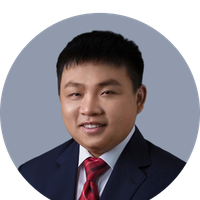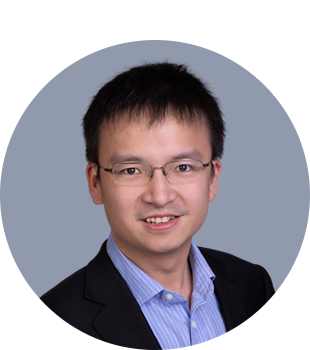Dr. Wang has made significant contributions to the invention of ‘sono-optogenetics.' In this technology, Dr. Wang and his collaborators creatively used focused ultrasound to trigger light emission for deep-brain optogenetic stimulation in a non-invasive manner. One of the long-standing challenges of optogenetic neural modulation comes from the invasive implantation of optical fibers, which leads to acute tissue damage and a chronic immune response. This very challenge also limits the clinical translation of optogenetics for more than a decade. Dr. Wang and his collaborators set out to ask a key question to address this long-standing challenge: can we deliver light sources via endogenous vasculature, thereby offering a much less invasive optical interface in the brain than fiber implantation? They worked together to identify a few unique nanomaterials, which can absorb focused ultrasound and emit light in return, as the candidates of such 2 light sources.
Over the past decade, optogenetics has increasingly become an important technology for neuroscience research and the future treatment methods of neurological disorders such as autism, anxiety, depression, Parkinson's disease, and Alzheimer's disease through the precise spatiotemporal control of neural activity with neuronal-targeting specificity. Although optogenetics-enabled, cell-targeted neuromodulation is considered to be a breakthrough technology for studying neuroscience. There are two drawbacks of this technique, especially for its clinical use: Firstly, due to limited tissue penetration of visible light, the optogenetics stimulation requires invasive craniotomy and intracranial implantation of tethered optical fibers for in vivo optogenetics stimulation. Secondly, expression of opsins requires viral transduction, which suffers from a number of limitations such as lack of economic scalability for manufacturing, taking several weeks for expression, limitations on maximum gene size, host immune response, and stability issues in the peripheral nervous system.
During his postdoctoral research at Stanford, he has developed nanoparticle-based approaches to address these two challenges. To address the first challenge, Wang co-developed mechanoluminescent nanoparticles that can be triggered by a brain-penetrant focused ultrasound to emit light for optogenetic stimulation, which is called Sono-optogenetics. The nanoparticles are injected into the circulating blood so that neither craniotomy nor intracranial implantation is required for this targeted neuromodulation approach. He has demonstrated the efficacy of this method for both in vitro control of cell activity and in vivo control of mice motor behavior. This approach is capable of achieving millisecond temporal resolution for controlling neurons firing at a certain frequency, together with a clinically needed potential penetration depth of >10cm. This research was published in Proceedings of the National Academy of Sciences (PNAS). To address the second challenge, he observed that suitably functionalized gold nanorods could be rapidly internalized by neuronal axon terminals, actively transported through neuronal axons, and used for modulating projection-specific neural activity under near-infrared light both in cultured neurons and freely behaving mice. In particular, he has demonstrated the application of this technology to modulate mice behavior in place-preference tests through modulating neural activity in a specific brain projection. This method is safe, biocompatible, and without the need for using a virus or genetic materials. This research was funded by NIH Mentored Research Scientist Development Award (K01) and presented at American Institute of Chemical Engineers (AICHE) Annual Meeting.
In summary, these innovations are expected to move targeted neural stimulation technology closer to treating complex neurological diseases in clinical settings.




